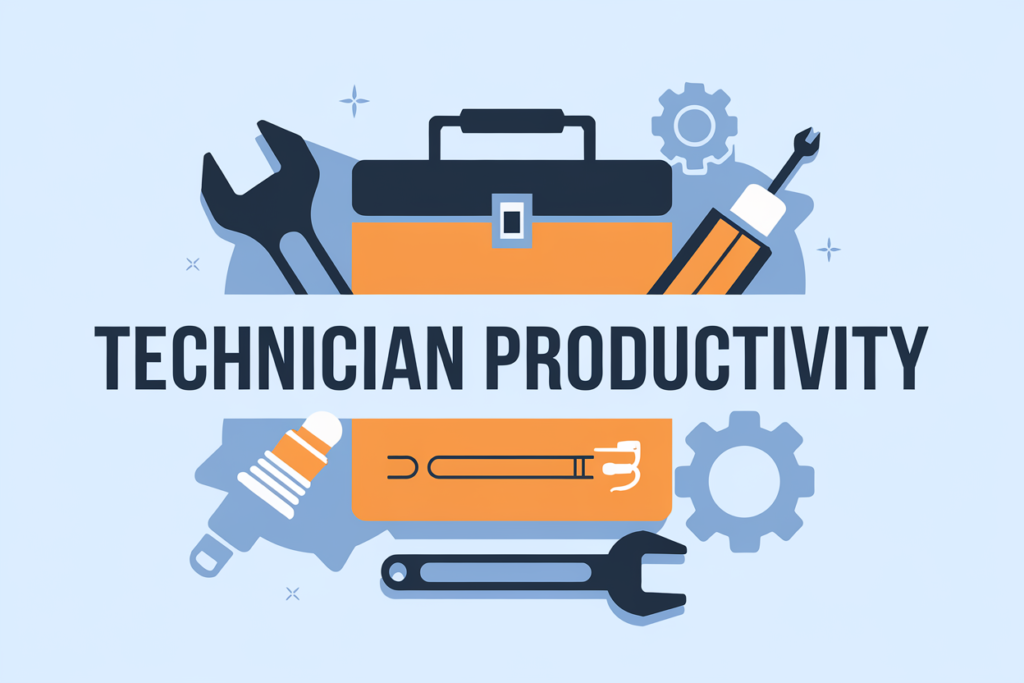Technician productivity isn’t just about getting more work done—it’s the backbone of success in field service industries. Efficient technicians mean faster problem-solving, happier customers, and healthier profit margins. As technology evolves, tools like mobile apps, IoT devices, and smart wearables are transforming how work gets done in the field. From real-time data access to optimized scheduling, these innovations are helping businesses streamline operations while meeting rising customer expectations. Whether it’s reducing downtime or improving first-time fix rates, a focus on productivity is driving service companies toward a more efficient and competitive future.
The Importance of Technician Productivity
Technician productivity plays a critical role in the success of any service-based business. Whether it’s completing repairs, troubleshooting technical issues, or providing customer support, productive technicians drive efficiency and elevate business outcomes. Let’s break down the key ways technician productivity influences profitability, customer satisfaction, and even employee morale.
Impact on Business Profitability
When technicians are more productive, businesses save time and money. Productive technicians complete more jobs in less time, which directly reduces operational costs like overtime, fuel, and resources. On the flip side, higher productivity can also increase revenue by enabling businesses to take on additional work without needing to scale their workforce.
For example:
- Companies with an 80% productivity rate from their technicians often see a significant reduction in non-billable hours, increasing profitability.
- According to industry studies, improving technician productivity by 10% can reduce response times and increase first-time fix rates, saving businesses thousands in follow-ups and warranty work.
Think of it like this: a technician who finishes their tasks one hour earlier either opens the door to take on another paying job or reduces overhead expenses. They’re not just fixing problems—they’re optimizing your bottom line.
Enhancing Customer Experience
In today’s competitive market, speed and reliability are customer priorities. When technicians are efficient, they can solve problems faster, leading to shorter waiting times and higher first-time fix rates. Customers value businesses that respect their time and fix issues quickly without multiple visits.
Some key benefits include:
- Higher first-time fix rates: Customers don’t want recurring trips for the same problem. Productive technicians ensure issues are resolved on the first visit, which boosts satisfaction.
- On-time service delivery: Timeliness builds trust. Technicians sticking to schedules leave a lasting positive impression.
The real game-changer? Satisfied customers become loyal advocates. They leave positive reviews, refer friends, and contribute to long-term retention. A productive team isn’t just improving internal metrics—it’s directly building your brand’s reputation and ensuring repeat business.
Boosting Technician Morale
It’s easy to overlook the connection between productivity and job satisfaction, but they’re closely linked. A supportive work environment that promotes efficiency helps technicians feel valued and fulfilled in their roles. When outcomes improve, employees take pride in their contributions.
Imagine a technician constantly juggling poorly planned schedules and incomplete tasks due to lack of proper tools. Frustration eventually creeps in, and morale dips. On the other hand:
- Accessible tools and clear workflows make technicians feel empowered, reducing burnout.
- Celebrating small wins, like hitting productivity targets or receiving customer praise, keeps motivation high.
Happy technicians not only work better—they stick around longer. Lower turnover means you maintain experienced professionals on your team, which further boosts productivity and, by extension, company success. Bottom line? Investing in productivity isn’t just about numbers; it’s about creating a cycle of positivity for customers and employees alike.
Best Practices for Improving Technician Productivity
Improving technician productivity requires more than just expecting better results—it demands purposeful strategies and tools that enable efficiency. From training to technology, each piece contributes to building a high-performing team. Let’s explore the solutions that make a difference.
Comprehensive Training Programs
Technicians need more than just an initial onboarding process—they need access to ongoing training programs to stay sharp. In fast-evolving industries, skills and knowledge must grow alongside changing tools and customer expectations. Regular sessions help technicians master new equipment, update compliance protocols, or learn tips for solving common issues faster.
For example:
- Offer online learning modules for technical troubleshooting or safety updates.
- Host workshops where technicians can share field experiences and solutions with teammates.
Think of it like upgrading software: technicians need updates to stay effective. A well-trained team not only works smarter but also gains confidence in handling complex jobs, leading to significant boosts in productivity.
Effective Communication Channels
Clear and real-time communication is the backbone of efficient operations. Whether it’s coordinating schedules or getting instant job details, technicians thrive when they’re connected. Introducing the right communication tools can eliminate guesswork and save valuable time.
Some reliable solutions include:
- Mobile apps that provide task updates, job history, or customer insights.
- Instant messaging platforms for quick team collaboration or supervisor guidance.
A connected technician is an empowered technician. If your team isn’t waiting on callbacks or struggling with outdated instructions, they’ll focus more energy on getting the job done right.
Leveraging Technology for Efficiency
The right technology does more than speed things up—it transforms how technicians operate. With tools designed to eliminate manual processes, your team can accomplish more in less time while reducing errors.
Here’s what to consider:
- GPS tracking: Helps technicians find the most efficient routes to save drive time.
- Automated dispatch systems: Assign jobs based on skill, location, and availability, ensuring the right person handles the task.
- Optimized routing software: Minimizes fuel costs and prevents delays by suggesting the fastest paths for multiple appointments.
Think of it as building a toolkit that works smarter, not harder. When technology handles logistics, technicians can focus on what they do best.
Data-Driven Decision Making
Collecting and analyzing data isn’t just for managers—it directly benefits technicians and their workflow. Regular performance reviews help pinpoint inefficiencies and offer solutions tailored to real-world challenges.
Why does this matter?
- Identify bottlenecks: Maybe certain jobs take too long due to outdated equipment.
- Track trends: Notice if response times improve after implementing new routing tools.
- Set goals: Use historical data to motivate technicians with measurable, achievable productivity targets.
Seeing data in action creates clarity. It takes the guesswork out of improvement and makes progress easier to measure for everyone involved.
Safety and Compliance Measures
Safety isn’t just a priority—it’s a productivity booster. A technician who feels safe and well-supported works more efficiently. Beyond obvious physical dangers, compliance lapses can create legal issues and downtime that disrupt workflows.
Focus on:
- Establishing a strong safety culture where protocols aren’t optional but standard.
- Providing regular updates to keep technicians compliant with changing regulations.
- Offering ergonomic tools to prevent injuries after long hours or repetitive motions.
Think of safety as both a shield and a springboard. When technicians know their well-being is cared for, they work with focus and speed, worry-free.
Key Metrics to Measure Technician Productivity
Understanding and tracking the right metrics is essential to evaluate technician productivity accurately. These indicators not only shed light on performance but also help fine-tune processes, reduce inefficiencies, and deliver better customer outcomes. Let’s explore the key metrics that every service-based business should prioritize.
Response and Job Completion Times
Time is money, especially when it comes to field service operations. Response time measures how quickly a technician can address service requests, while job completion time tracks the duration it takes to finish tasks from start to finish. These numbers are more than just time stamps—they’re insights into how organized and efficient your scheduling and resource allocation processes are.
Picture this: a delayed response or drawn-out job completion doesn’t just frustrate customers, it could mean missed opportunities for additional calls. By closely monitoring these metrics, you can:
- Optimize technician schedules to reduce downtime.
- Ensure faster responses during peak demand.
- Identify areas where processes like dispatching or routing can be streamlined.
Keeping these times low isn’t just about speed—it’s about ensuring technicians are properly equipped and consistently available to deliver results quickly.
Customer Satisfaction Scores
Ever wonder what your customers really think about your service? Customer satisfaction scores (CSAT) offer a fast and reliable picture of how your technicians are performing. This metric combines direct feedback from customers post-service, often using surveys or ratings, to evaluate the quality and efficiency of the work.
Why is this crucial? A happy customer doesn’t just come back—they spread the word. Poor ratings could reveal recurring problems, like unresolved issues or ineffective communication. On the flip side:
- High satisfaction scores build trust and improve client retention.
- Identifying trends in feedback can guide technician training and service improvements.
Remember, customer feedback is like a mirror—it reflects not only individual performance but the effectiveness of your workflows and processes.
First-Time Fix Rate
Your first-time fix rate (FTFR) measures how often technicians solve a problem during the initial visit without needing follow-ups. This metric is a direct reflection of competency, preparation, and resource management. Lower rates mean increased operational costs with more trips, longer problem resolutions, and dissatisfied customers.
Think of it as a one-shot opportunity. Every time a technician returns to fix the same problem, that’s lost time and money. Boosting the FTFR includes:
- Equipping technicians with the right tools and knowledge.
- Ensuring access to detailed job and equipment history.
- Providing real-time support to handle unexpected issues.
High FTFR not only improves customer satisfaction but also frees up technicians to take on more jobs, increasing overall efficiency.
Utilization Rate
Utilization rate measures how much of a technician’s available time is spent on billable or productive work. This is often expressed as a percentage of total available hours. A high utilization rate means your team is focused on core tasks that drive revenue and minimize idle time. On the other hand, a low rate flags underutilized resources that could cost your business in inefficiencies.
For example:
- A technician working only 5 out of their 8-hour shift has a utilization rate of 62.5%.
- With improved task allocation, scheduling, or call prioritization, that rate could climb to over 85%, unlocking hidden productivity potential.
Keeping utilization rates in check ensures individual technicians, and the team as a whole, are as productive as possible without overloading or burnout.
Documentation and Performance Analysis
Detailed service documentation is often overlooked, but it plays a massive role in long-term productivity. By capturing every aspect of a technician’s performance—what they did, how they solved an issue, time taken, tools used—you create a treasure trove of data for analysis and improvement.
Here’s why it matters:
- Identifies bottlenecks in workflows or gaps in training.
- Builds a benchmark that technicians can use to self-assess and improve.
- Provides management with actionable insights to upgrade processes or allocate resources more effectively.
Consider it like a technician “playbook.” No one likes extra paperwork, but clear and concise documentation ensures smarter decision-making and fewer inefficiencies in the future.
By focusing on these key metrics, businesses can create a culture of accountability and productivity while paving the way for smoother operations and happier customers. Tracking these isn’t just data collection; it’s about creating actionable strategies to drive technician and business success.
Emerging Trends in Technician Productivity
Technician productivity is constantly evolving, with new technologies and strategies shaping how work gets done. As industries strive to improve efficiency and meet rising demand, emerging trends are offering innovative ways to empower technicians and streamline service delivery. From cutting-edge tools to smarter processes, these advancements are changing the game for businesses. Let’s explore the most notable trends driving technician productivity forward.
Remote Support with Augmented Reality (AR)
Augmented reality (AR) is no longer just for gaming or entertainment—it’s rapidly becoming a go-to tool for technicians. Imagine a world where a technician in the field can instantly connect with an expert back at headquarters, sharing a live feed of their workspace. Through AR-enabled devices, support teams can overlay instructions, highlight specific components, or even simulate walkthroughs directly in a technician’s field of view.
This has several benefits:
- Reduced travel time: Instead of sending a second technician, remote support provides real-time solutions.
- Faster problem-solving: With visual guidance, technicians can resolve complex issues more efficiently.
- Improved training: AR tools double as learning aids, helping newer technicians tackle unfamiliar tasks with confidence.
AR is transforming how knowledge is shared and applied, bridging the gap between physical distance and expertise.
Artificial Intelligence and Predictive Maintenance
Artificial intelligence (AI) is becoming a cornerstone of technician productivity, particularly in preventive and predictive maintenance. By analyzing equipment data in real-time, AI can forecast potential failures before they occur, allowing technicians to address issues proactively.
Here’s why this matters:
- Minimizing downtime: Predictive insights help schedule maintenance during non-operational hours, keeping systems running smoothly.
- Optimized schedules: AI-driven tools prioritize tasks based on urgency, reducing wasted trips.
- Resource management: Technicians arrive on-site with the right parts and tools, thanks to AI’s accurate diagnostics.
Predictive maintenance isn’t just about fixing problems—it’s about preventing them altogether, saving time and costs for businesses while delivering better service outcomes.
Cloud-Based Solutions for Flexibility
Gone are the days of paper forms and manual scheduling. Cloud-based platforms are transforming how technicians manage their work, offering real-time access to schedules, project updates, and customer information from anywhere.
The benefits of cloud solutions include:
- Seamless collaboration: Teams can update and share information instantly, avoiding miscommunication.
- Remote access: Technicians can retrieve project details or troubleshooting guides from their phones or tablets, even in remote locations.
- Scalability: As businesses grow, cloud solutions adapt without the need for costly infrastructure upgrades.
In many ways, cloud-based software acts as an all-in-one command center, ensuring technicians stay connected, informed, and productive.
Addressing Labor Shortages
Labor shortages are pushing companies to rethink how they approach technician efficiency. With fewer hands on deck, maximizing the output of each technician has become critical. What’s the solution? Smarter tools and streamlined workflows.
Businesses are tackling labor shortages by:
- Automating routine tasks: Freeing up technicians for higher-value work.
- Cross-training employees: Ensuring technicians are versatile enough to handle diverse challenges.
- Improving service times: Optimizing routes and schedules to fit more calls into a day without overloading technicians.
While the shortage of skilled workers is a challenge, it’s also an opportunity to innovate and build more efficient teams.
Balancing Technology with Human Elements
As much as technology has revolutionized technician productivity, it’s important to keep the human element front and center. Customer service is still a deeply personal experience, and technicians often serve as the face of a company.
Key considerations for balance include:
- Empathy in service: Using technology to assist technicians, not replace them, ensures that customer interactions remain genuine.
- Training on soft skills: While tools handle the technical side, technicians need strong communication skills to deliver excellent service.
- Human oversight: AI and automation should complement technicians, adding value without eroding trust or control.
Think of this as a partnership—technology and human expertise working hand-in-hand to deliver better, faster, and more reliable service. At the core of productivity is the understanding that technicians are more than just problem solvers; they’re critical to building lasting customer relationships.
Conclusion
Technician productivity isn’t just a metric—it’s the heartbeat of operational success. A highly productive team leads to seamless workflows, happier customers, and stronger profit margins. By focusing on training, communication, and technology-driven solutions, businesses can equip their technicians to perform at their best.
Emerging innovations like augmented reality, AI, and cloud-based tools are reshaping what’s possible. Companies that embrace these changes and invest in their workforce will stay competitive and thrive in a rapidly evolving market.
Start improving productivity now by implementing strategies outlined here and staying informed on future trends. Prioritize your technicians’ tools and support—they’re the key to building a successful, customer-focused operation.
Discover more from Online Calculators | Free Calculator Tools
Subscribe to get the latest posts sent to your email.


